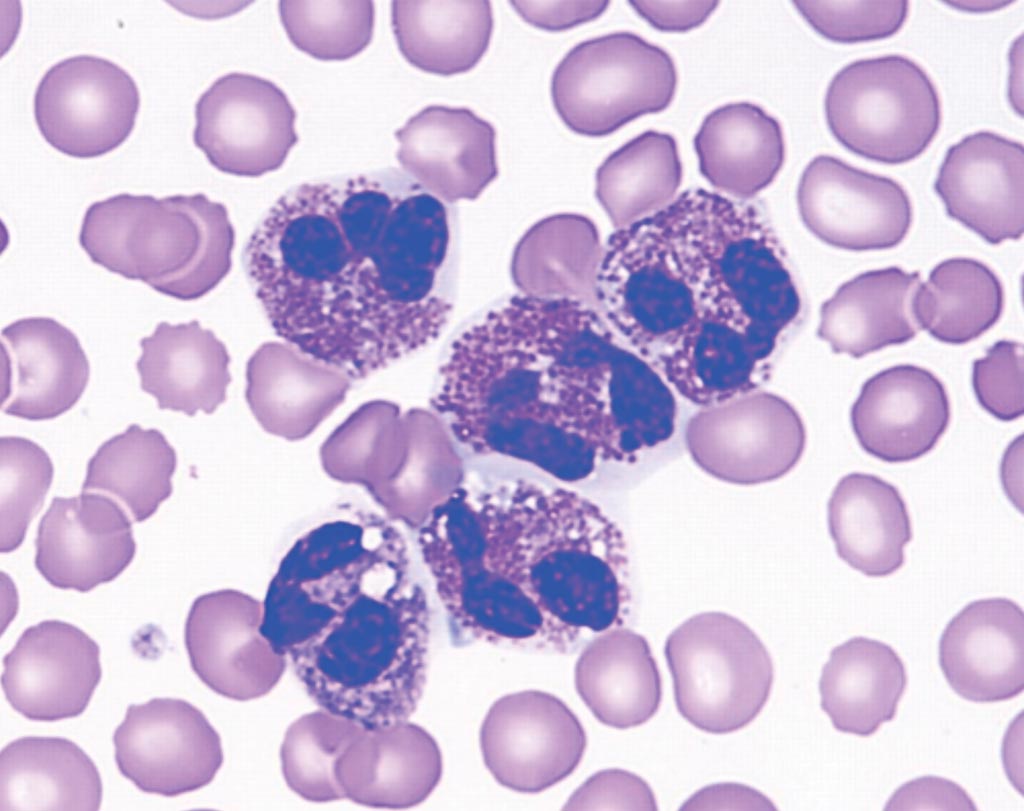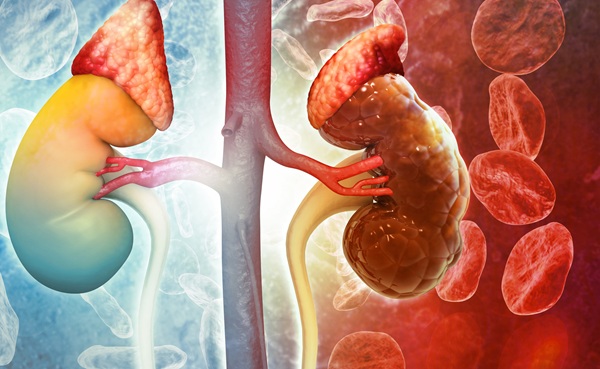Eosinophilic Biomarker Found for Aggressive IBD
|
By LabMedica International staff writers Posted on 14 Dec 2017 |

Image: Peripheral bloods smear showing five eosinophils, from a patient with eosinophilia (Photo courtesy of the Hospital for Sick Children, Toronto).
Peripheral blood eosinophilia (PBE) in inflammatory bowel disease is associated with ulcerative colitis (UC) and active disease. Little data exist on the long-term impact of PBE on disease course.
Inflammatory bowel disease (IBD) is a term mainly used to describe two conditions: ulcerative colitis and Crohn's disease. Ulcerative colitis and Crohn's disease are long-term conditions that involve inflammation of the gut. Ulcerative colitis only affects the colon or large intestine.
A large group of medical scientists working with the University of Pittsburgh Medical Center (Pittsburgh, PN, USA) performed a registry analysis of a consented, prospective, natural history IBD cohort at a tertiary center from 2009 to 2014. Demographics, comorbidities, disease activity, healthcare utilization, and time to hospitalization or surgical resection of patients who displayed PBE were compared to patients without PBE.
The team reported that of the 2,066 IBD patients, 19.2% developed PBE. PBE was significantly associated with UC, extensive colitis, and shorter disease duration. Over six years, PBE patients had more active disease, concurrent C-reactive protein elevation, healthcare utilization (hospitalization and IBD surgery), and more aggressive medical therapy (prednisone and anti- tumor necrosis factor). Patients with PBE had a significantly reduced time to hospitalization in both UC and Crohn’s disease (CD) and reduced time to colectomy in UC. PBE remained significantly associated with hospitalization and surgery in both CD and UC. New diagnosis of UC with PBE was associated with increased steroid and anti- tumor necrosis factor requirement.
The authors concluded that the multi-year study of a large IBD cohort suggests that peripheral blood eosinophilia represents a biomarker of a distinct IBD subgroup, with a unique inflammatory signature, and at risk for worse clinical outcomes. The study was published on November 7, 2017, in The American Journal of Gastroenterology.
Related Links:
University of Pittsburgh Medical Center
Inflammatory bowel disease (IBD) is a term mainly used to describe two conditions: ulcerative colitis and Crohn's disease. Ulcerative colitis and Crohn's disease are long-term conditions that involve inflammation of the gut. Ulcerative colitis only affects the colon or large intestine.
A large group of medical scientists working with the University of Pittsburgh Medical Center (Pittsburgh, PN, USA) performed a registry analysis of a consented, prospective, natural history IBD cohort at a tertiary center from 2009 to 2014. Demographics, comorbidities, disease activity, healthcare utilization, and time to hospitalization or surgical resection of patients who displayed PBE were compared to patients without PBE.
The team reported that of the 2,066 IBD patients, 19.2% developed PBE. PBE was significantly associated with UC, extensive colitis, and shorter disease duration. Over six years, PBE patients had more active disease, concurrent C-reactive protein elevation, healthcare utilization (hospitalization and IBD surgery), and more aggressive medical therapy (prednisone and anti- tumor necrosis factor). Patients with PBE had a significantly reduced time to hospitalization in both UC and Crohn’s disease (CD) and reduced time to colectomy in UC. PBE remained significantly associated with hospitalization and surgery in both CD and UC. New diagnosis of UC with PBE was associated with increased steroid and anti- tumor necrosis factor requirement.
The authors concluded that the multi-year study of a large IBD cohort suggests that peripheral blood eosinophilia represents a biomarker of a distinct IBD subgroup, with a unique inflammatory signature, and at risk for worse clinical outcomes. The study was published on November 7, 2017, in The American Journal of Gastroenterology.
Related Links:
University of Pittsburgh Medical Center
Latest Pathology News
- Rapid Low-Cost Tests Can Prevent Child Deaths from Contaminated Medicinal Syrups
- Tumor Signals in Saliva and Blood Enable Non-Invasive Monitoring of Head and Neck Cancer
- Common Health Issues Can Influence New Blood Tests for Alzheimer’s Disease
- Blood Test Formula Identifies Chronic Liver Disease Patients with Higher Cancer Risk
- Tunable Cell-Sorting Device Holds Potential for Multiple Biomedical Applications
- AI Tool Outperforms Doctors in Spotting Blood Cell Abnormalities
- AI Tool Rapidly Analyzes Complex Cancer Images for Personalized Treatment
- Diagnostic Technology Performs Rapid Biofluid Analysis Using Single Droplet
- Novel Technology Tracks Hidden Cancer Cells Faster
- AI Tool Improves Breast Cancer Detection
- AI Tool Predicts Treatment Success in Rectal Cancer Patients
- Blood Test and Sputum Analysis Predict Acute COPD Exacerbation
- AI Tool to Transform Skin Cancer Detection with Near-Perfect Accuracy
- Unique Immune Signatures Distinguish Rare Autoimmune Condition from Multiple Sclerosis
- Simple Optical Microscopy Method Reveals Hidden Structures in Remarkable Detail
- Hydrogel-Based Technology Isolates Extracellular Vesicles for Early Disease Diagnosis
Channels
Clinical Chemistry
view channel
POC Breath Diagnostic System to Detect Pneumonia-Causing Pathogens
Pseudomonas aeruginosa is a major cause of hospital-acquired and ventilator-associated pneumonia, particularly in lung transplant recipients and patients with structural lung disease. Its ability to form... Read more
Online Tool Detects Drug Exposure Directly from Patient Samples
Doctors often rely on patient interviews and medical records to determine what medications a person has taken, but this information is frequently incomplete. People may forget drugs they used, take over-the-counter... Read moreMolecular Diagnostics
view channel
Blood Biomarker Improves Early Brain Injury Prognosis After Cardiac Arrest
After a cardiac arrest, many patients remain unconscious for days, leaving doctors and families facing uncertainty about whether meaningful recovery is possible. Current tools to assess brain damage, including... Read more
Biomarkers Could Identify Patients at High Risk of Severe AKI After Major Surgery
Acute kidney injury is one of the most common and dangerous complications after major surgery, particularly among patients in intensive care. Even mild impairment of kidney function can lead to long-term... Read more
CLIA Test Identifies Head and Neck Cancer Recurrence from Post-Surgical Lymphatic Fluid
While the lymphatic system’s critical role in metastasis has long been recognized, routine access to patient lymph has been elusive. Now, a non-invasive process can access lymph through the collection... Read moreImmunology
view channelBlood Test Could Detect Adverse Immunotherapy Effects
Immune checkpoint inhibitors have transformed cancer treatment, but they can also trigger serious immune-related adverse events that damage healthy organs and may become life-threatening if not detected early.... Read more
Routine Blood Test Can Predict Who Benefits Most from CAR T-Cell Therapy
CAR T-cell therapy has transformed treatment for patients with relapsed or treatment-resistant non-Hodgkin lymphoma, but many patients eventually relapse despite an initial response. Clinicians currently... Read moreMicrobiology
view channel
Blood-Based Diagnostic Method Could Identify Pediatric LRTIs
Lower-respiratory tract infections (LRTIs) are a leading cause of illness and death worldwide, and pneumonia is the leading infectious cause of death in children under five, claiming the lives of over... Read more
Rapid Diagnostic Test Matches Gold Standard for Sepsis Detection
Sepsis kills 11 million people worldwide every year and generates massive healthcare costs. In the USA and Europe alone, sepsis accounts for USD 100 billion in annual hospitalization expenses.... Read moreRapid POC Tuberculosis Test Provides Results Within 15 Minutes
Tuberculosis remains one of the world’s deadliest infectious diseases, and reducing new cases depends on identifying individuals with latent infection before it progresses. Current diagnostic tools often... Read more
Rapid Assay Identifies Bloodstream Infection Pathogens Directly from Patient Samples
Bloodstream infections in sepsis progress quickly and demand rapid, precise diagnosis. Current blood-culture methods often take one to five days to identify the pathogen, leaving clinicians to treat blindly... Read morePathology
view channel
Rapid Low-Cost Tests Can Prevent Child Deaths from Contaminated Medicinal Syrups
Medicinal syrups contaminated with toxic chemicals have caused the deaths of hundreds of children worldwide, exposing a critical gap in how these products are tested before reaching patients.... Read more
Tumor Signals in Saliva and Blood Enable Non-Invasive Monitoring of Head and Neck Cancer
Head and neck cancers are among the most aggressive malignancies worldwide, with nearly 900,000 new cases diagnosed each year. Monitoring these cancers for recurrence or relapse typically relies on tissue... Read more
Common Health Issues Can Influence New Blood Tests for Alzheimer’s Disease
Blood-based tests for Alzheimer’s disease are transforming diagnosis by offering a simpler alternative to spinal taps and brain imaging. However, many people evaluated at memory clinics also live with... Read more
Blood Test Formula Identifies Chronic Liver Disease Patients with Higher Cancer Risk
Chronic liver disease affects millions worldwide and can progress silently to hepatocellular carcinoma (HCC), one of the deadliest cancers globally. While surveillance guidelines exist for patients with... Read moreTechnology
view channel
Machine Learning Models Diagnose ALS Earlier Through Blood Biomarkers
Amyotrophic lateral sclerosis (ALS) is a rapidly progressive neurodegenerative disease that is notoriously difficult to diagnose in its early stages. Early symptoms often overlap with other neurological... Read more
Artificial Intelligence Model Could Accelerate Rare Disease Diagnosis
Identifying which genetic variants actually cause disease remains one of the biggest challenges in genomic medicine. Each person carries tens of thousands of DNA changes, yet only a few meaningfully alter... Read moreIndustry
view channel
BD and Penn Institute Collaborate to Advance Immunotherapy through Flow Cytometry
BD (Becton, Dickinson and Company, Franklin Lakes, NJ, USA) has entered into a strategic collaboration with the Institute for Immunology and Immune Health (I3H, Philadelphia, PA, USA) at the University... Read more




















